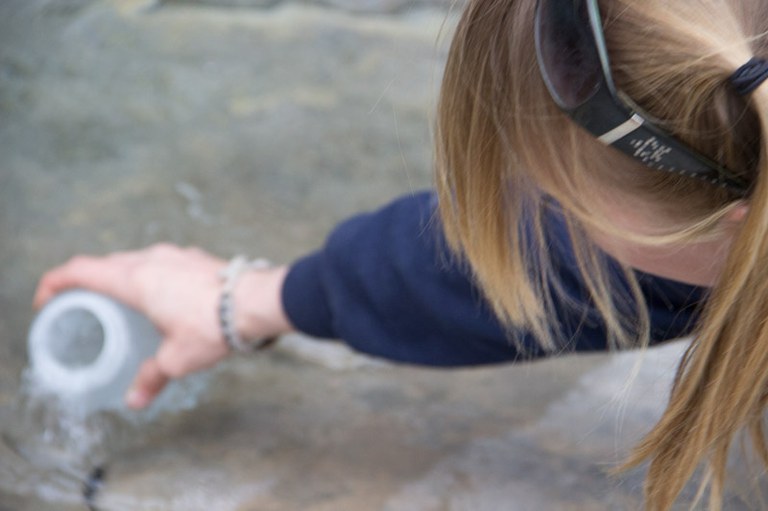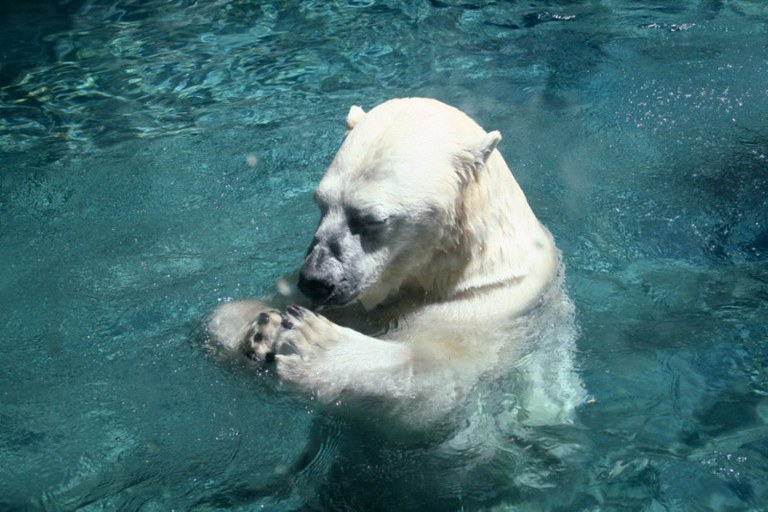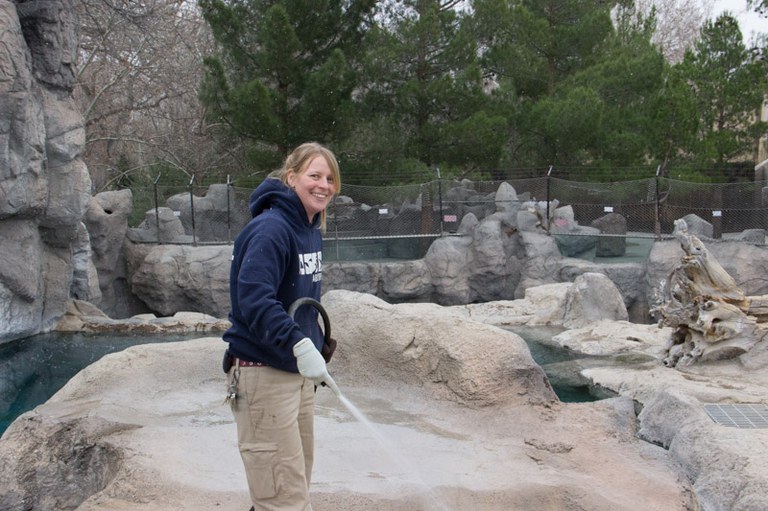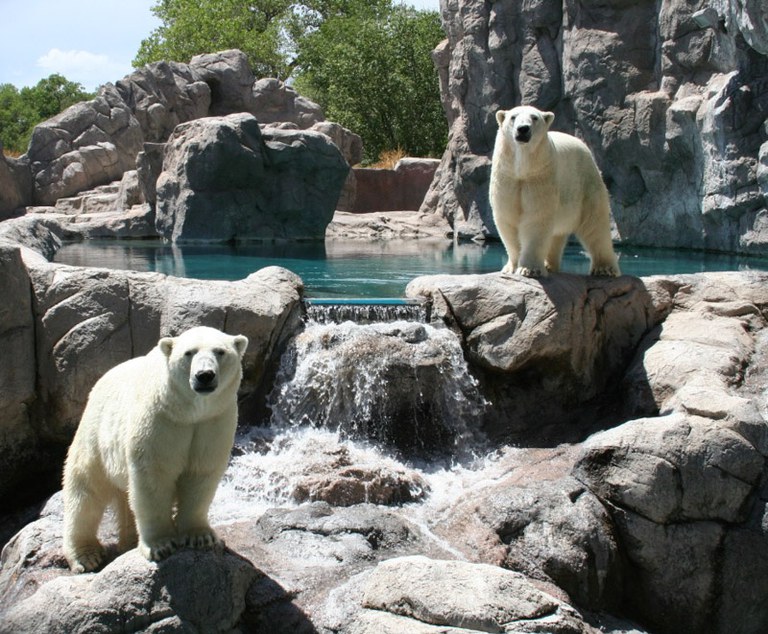Plunging in with Koluk and Kiska
Chow time
It's 8:30 a.m. and Jenn Ericksen starts preparing Koluk and Kiska’s breakfast—a combination of fruits, meat and “polar bear chow” (the latter resembles very large dog kibble).
Ericksen says the meat is their favorite, though Koluk will eat just about anything, bones and all. Kiska is the pickier of these twin brothers. He has a distinct dislike for poultry, in particular.
Ericksen, a senior zookeeper at the ABQ BioPark, spends several hours each day feeding, training and enriching the lives of these two bears.
She weighs all of their food—both are on specific diets—and loads it into metal buckets. When she exits the kitchen, Kiska and Koluk are waiting in their bedrooms, ready to eat (Ericksen began her day by shifting the bears into their own bedrooms—this ensures her safety and also separates the bears from each other so they each get their own diet).*
Ericksen feeds each of them by sliding their breakfast into a downward sloping chute (a necessary safety precaution when feeding two Artic predators that weigh in at about 900 and 800 pounds). The food slides down and they catch it like pros.
While she feeds the bears, Ericksen explains how to differentiate between the two. Kiska is smaller with a rounder face and a shorter muzzle, has a little bit of a yellow tone to his fur and has all his teeth. Koluk has a longer snout and narrower face. As Ericksen feeds Koluk, she points out his half-missing lower left canine—he lost it due to a planned root canal as a youngster.
You also can tell the two apart based on their personalities—Kiska, the dominant of the two, is a very fast moving bear. Koluk is a mellower guy.
*Ericksen never enters the enclosure with the bears.
Doing chores—polar bear style

Polar bears are listed as a vulnerable species by the International Union for Conservation of Nature. The BioPark is participating in a thermoregulation study with researchers from the University of Guelph in Ontario, Canada, which seeks to gain insights into polar bear physiology and the species’ ability to adapt to warming temperatures. Researchers are monitoring data from 22 polar bears in various latitudes throughout Canada and the United States.
This brings Ericksen to her next daily task—taking the pool’s water temperature, grabbing a water sample and picking up polar bear feces for analysis. The data from these samples will be used for the Canadian team’s research.
After collecting the samples, it’s time to do a little house cleaning. At about 9 a.m., Ericksen scoops the remainder of the debris around the enclosure and then uses a hose to spray down the entire area. She also disinfects the exhibit. This keeps the polar bear digs clean, maintaining a healthy habitat for the brothers. In addition, she performs a detailed evaluation of their habitat to ensure the bears’ safety.
Divers enter the pool (after the bears have been shifted to their bedrooms) once a week in the summer and once every other week in the winter to scrub algae build up off the substrate and viewing glass. They also check water levels for things like acidity and pH a few times a day via a specialized computer monitoring system. This ensures that the pool is always healthy and safe for Koluk and Kiska to swim.
At this point, Koluk and Kiska are getting a bit restless—it’s apparent that they want to go back into their habitat, which is equipped with a great view of Tingley Beach, the Bosque Trail and the carnivores section of the zoo (not to mention a pool complete with a water slide and three waterfalls).
Enriching their lives

Environmental and behavioral enrichment provides choice, change and complexity to zoo animals’ days, and the BioPark’s mission is to incorporate an environmental enrichment program that will provide for the psychological well-being and overall enhanced animal welfare environment for all BioPark animals.
To complete the morning’s tasks, Ericksen tosses out some assorted berries and cheerios—this enrichment food encourages the bears’ foraging instincts while also providing them a yummy treat.
Ericksen says creating enrichment for the bears is one of her favorite parts of working with them. The brothers’ favorite toys are balls, and Ericksen says they show great paw dexterity when playing—they bounce the balls and can even balance them on a paw.
She also says the bears enjoy scent enrichment, such as garlic stuck inside a toy. In addition, Kiska and Koluk love anything they can chew on.
The polar bears can also be a bit devious—the two like to break some of their toys by dropping them from the back wall.
“The hardest part (of enrichment) is trying to keep them entertained because they can go through things really fast,” Ericksen says.
Another way to add enrichment to the polar bears’ lives—while also making life easier for Ericksen, Koluk and Kiska—is operant conditioning (training), a task that Ericksen loves.
“As big and amazingly powerful as these guys are, they work with you really well,” Ericksen says. “Some people say polar bears are smarter than your average dog.”
To train Koluk and Kiska, Ericksen asks the bears to offer species-appropriate behaviors and rewards them for those behaviors (this is the same method used across the zoo with all species). She uses a protective contact method (she never enters the same space with the bears).
Koluk and Kiska have learned a handful of behaviors, including opening their mouth, sitting, lying down (only Kiska does this one) and presenting their paws to the mesh. Ericksen is currently teaching the two to present an ear, which could be helpful if one of them contracts an ear infection. She is also teaching them to present a paw through a door for blood draws and to lean into the fence to present their side. All of these behaviors make it easier to perform medically necessary procedures.
For today, Ericksen has other tasks to attend to, but she’ll return to Kiska and Koluk around mid-day for a training session along with a special fish toss.
For the love of the bears

A native of Chicago, Ericksen came to the BioPark in 2006. She got involved with polar bears by way of becoming a veterinary technician, then clinic keeper, then keeper in several other areas like Tropical America and hoof stock. She started working with the bears briefly in 2008, and then again in 2010. She says she loves working with Kiska and Koluk.
“The first time I worked with these guys, they were so amazing. Being with them is what made me start loving them.”
And it seems the feeling is mutual—Ericksen says she finally experienced the “polar bear purr” from Koluk in late 2015. Polar bear purr—also known as chuffing—is a vocalization that a polar bear makes when they trust a person or another animal.
“That was the most amazing thing for me,” says Ericksen.
Story: Tina Deines


